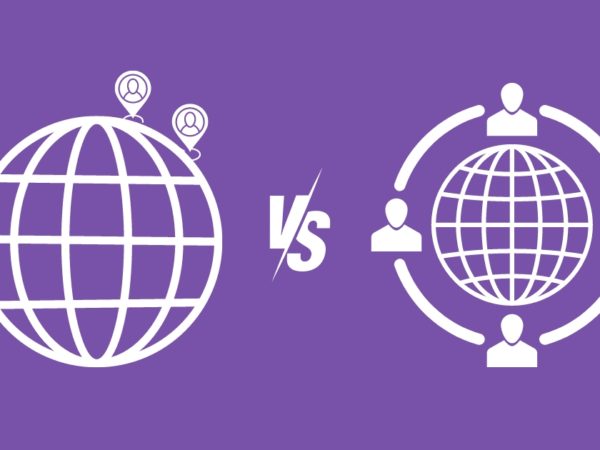
Incorporating technology in business operations isn’t just an efficiency boost anymore; it’s a necessity. However, following a tech-forward business approach does have its challenges.
89% of the businesses have already adopted a digital-focused strategy or plan to do so. I am sure your business is one of them too. However, 70% of businesses fail to achieve their expected goals from the transformation, and only 12% report that they managed to sustain their goals for more than 3 years.
Such a high chance of failure and difficulties in achieving intended goals is a clear sign that taking a tech-forward approach isn’t easy. Businesses face many challenges during the transformation. For success, you need to know these challenges and be ready.
To help you with this, I am going to list the most common challenges businesses face when adopting a tech-forward approach.
What’s a Tech-Forward Business Approach?
A tech-forward approach involves using technology to streamline business operations and enhance efficiency. Technology implementation can be in the form of software or hardware, such as CRM software or self-service kiosks.
However, in contemporary discussions about tech transformation, the primary focus is often on the software side, to the extent that it is interchangeably referred to as digital transformation
Technology introduces automation, better integration, comprehensive data analytics, and better access (cloud computing) to increase efficiency and help the business scale. Below I am listing some prominent benefits of a tech-forward business approach:
Benefits of a Tech-Forward Business Approach
Increased Efficiency
Technology streamlines workflows and introduces automation that increases the overall efficiency of business operations. Better analytics also help with better decisions that are more effective.
Better Customer Experience
Customers get a more personalized experience with fast service, like the ability to chat with a support representative quickly. If you are using technology to create a better online presence, then It also allows customers to engage with your business at any time, 24/7.
Reduced Costs
As efficiency increases, it also lowers costs. Automation takes the place of more expensive manual labor, streamlined operations minimize costly errors and waste of resources, and overall resource utilization is increased. All of this decreases your business functioning costs.
Gives a Competitive Edge
Better customer service, more marketing methods, easier adaption of new trends, etc., allow you to be better than your competitors who are less focused on technology adoption.
Overall, a tech-forward business approach ensures that your business can flourish in the current digital world and grow efficiently. Just make sure you keep the below challenges in mind during your transformation:
Neglecting Integration
Whether it’s business apps or the Internet of Things (IoT), integration of the system is very important for a successful setup. The technologies used in your business should integrate well with other related systems.
Without proper integration, your business efficiency will be heavily affected. Data may be duplicated, processes will require manual intervention, and communication between departments will slow down.
Furthermore, it will also affect other business functions, like the lack of centralized data for analytics and decision-making. Not to mention higher costs due to manual handling of redundant processes.
You need to make sure all your apps and devices work well together. For example, your CRM system must integrate well with your sales tools, so there will be no need to manually enter customer data. The same goes for hardware technologies too. Like if your business uses Windows devices, then it makes sense to choose Microsoft Azure as your cloud platform for seamless integration.
Thankfully, most of the business tools have a dedicated page on their website that shows the list of tools they officially integrate with. You can search online with the keyword “integration,” and the page should come up. Hootsuite, Quickbooks, Asana, and Square are a few business apps that I quickly searched while writing this, and they all had an app integration page.
Even if your required apps aren’t listed, you can check if the app offers integration through its API. Your IT team can use and manage the API integration even if the app doesn’t list it in its officially supported apps list.
Not Prioritizing Security
Technology usually involves making business data available online in the cloud and using cloud-based tools for day-to-day operations. This makes your business data vulnerable to unwavering cyber-attacks that can take advantage of any weakness in security.
Cyber-attacks are extremely detrimental to a business. They can lead to compromised customer data, financial losses, stop business functions, damage reputation, and cause legal issues. The Mr. Cooper data breach ($25 million estimated damage) and the Colonial Pipeline ransomware attack that directly impacted the day-to-day lives of people are good examples of cyber-attacks affecting business operations.
When focusing on a tech-forward approach, business security should be a foundational principle, not an afterthought. Before applying any technology, check how you can secure it beyond the built-in security features. Yes, you need to go beyond strong passwords or multi-factor authentication.
Endpoint protection, DNS filtering, and Zero Trust security are a few additional ways you can secure your business. Here are some reliable ways to secure your business to ensure it’s protected from cyber-attacks from all fronts (or backs). You can also use an all-in-one cyber security solution like Acronis Cyber Protect if you prefer a single app handling all your security needs.
Too Much Focus on the Best Tech
Opting for the best tech won’t magically boost your business to the top, it can actually have a negative impact. The most cutting-edge technology may have the best features, but your business must require those features to be worth the investment. Furthermore, you may not even have to shell out cash for many tools if free ones can handle your business needs, such as free CRM software.
Below are some downsides of running after the best tech:
- The best tool is usually much more expensive than the average and more difficult to apply and maintain. It’s a big waste of business resources if all the features aren’t required.
- Upgrading to the latest tech as it releases leads to unrequired disruption in business operations and waste of resources.
- Integration can be a huge hurdle when opting for the best tech, you need to make adjustments to ensure all the tech is well-integrated.
- Newer technology may not be the most stable and could lead to problems in your business operations.
- It may alienate current customers who may prefer the current mainstream technology.
- Employee adoption and education of new technology is an important consideration.
When searching for the right tech, look at the current needs of your business and possible increases in needs in the foreseeable future. For software, looking at the flexibility of packages/plans may be a more important factor. A tool with flexible plans will allow you to easily upscale or downscale operations to only use needed resources/features.
Workforce and Customer Adaptation
This is probably the biggest hurdle while taking a tech-forward approach. Employees and customers usually resist change, especially one that is more difficult to understand, like technology. Below is a quick list of reasons why employees and customers resist tech-forward changes:
Employees
- A lack of understanding of new technology creates discomfort in the routine.
- Fear of loss of job due to automation and technology replacing their roles.
- Lack of training can lead to employees not feeling confident in handling the new technology.
- Since technology is hard to understand, employees may not see an immediate benefit.
- Digitization usually involves more data of employees moving to the cloud which could raise privacy concerns.
Customers
- Privacy is one of the main concerns for customers as technology usually requires personal contact information that is saved in the cloud.
- Sudden changes in service and processes can burden customers with things they don’t know how to handle.
- Customers may be reluctant to learn if the new technology requires too much time and effort to learn.
- Customers may create loyalty to traditional processes and resist the seemingly unrequired change.
- They may have had negative experiences with technology in the past, like system failures or data breaches.
Age also plays a very important part for both customers and employees, as younger individuals are more adaptive, and older people resist change.
All of these problems can be fixed by providing proper knowledge and support. Any technology advancement you make, let everyone know about it beforehand and give clear reasons why it’s being applied. Give proper training and education during the transition and directly support individuals to help them use the technology properly.
I also recommend you divide the transition into stages, such as allowing both traditional and tech-focused methods at the start and slowly removing support for the traditional method. For example, when transitioning to digital receipts, offer both paper and digital receipt options but encourage customers to use digital receipts.
New Compliance and Regulations
Introducing technology comes with its own set of compliance and regulation rules that are usually much more complicated and prone to change.
This is especially true for data handling, as many new data protection laws come into effect when you store customer and employee data in the cloud. Regulations like GDPR, CCPA, HIPAA, and DPA are some well-known regulations your business will need to adhere to.
Not complying with these regulations can lead to dire consequences from regulatory bodies, including restrictions, fines, and reputation damage. The £20m fine to British Airways by ICO is a good example of noncompliance consequences.
Your business legal team will have to keep up with new compliance rules introduced with each technology upgrade. You can use an automatic compliance platform like Scrut to make this process easier. Furthermore, some of the business apps also have automatic compliance features that could help like digital payroll apps like ADP Payroll that handle taxation and compliance automatically.
Choosing the Right Vendors
Changing hardware or migrating to different software platforms isn’t easy to do. You need to make the right choices from the beginning to avoid any need for drastic changes to business operations.
The hardware manufacturers and software providers that directly fuel your tech transformation need to be reliable. The success of your tech-forward business ventures heavily depends on the products and services you get from the technology vendors.
Below are some key factors to consider when choosing a vendor:
- The vendor should have a reliable track of stable service.
- It should allow easy scaling of your business with flexible plans and support for high business demands.
- Robust security protocols and practices are very important. Also, check its compliance with industry-specific standards and regulations.
- Transparent costs and pricing models are crucial to avoid unexpected expenditures later. It’s also a plus if costs are flexible enough to accommodate businesses at different scales.
- Reliable customer support is important as well. You don’t want your business operations left stranded just because the vendor support team didn’t help in time.
- Innovation is another important factor to ensure you won’t have to change vendors later to get access to the latest technology. The vendor should be committed to adopting the latest changes in the specific industry.
Checking for all these factors and your preferences isn’t an easy task as there are usually a large number of providers for each product/service. However, you still need to go through this initial search, so below are some ways to get a better overview of a vendor:
- Read reviews and testimonials online. The testimonials on the vendor’s own website aren’t enough. Hands-on reviews and comparisons are very useful for knowing strengths and weaknesses.
- Do a background search and look for any negative events associated with the vendor, such as data breaches or legal penalties.
- Don’t be afraid to contact them directly to ask your questions. It will also help you see how reliable their customer support is.
- Ask them to give a breakdown of all costs associated with the service. If you think there might be additional services, ask about their pricing too.
- Ask for a demo or trial even if they don’t provide one officially.
- Sometimes, it’s hard to find what you are looking for directly on the website. Use Google to look using related keywords, such as “(app name) integrations” or “(vendor name) contact number. “
Ending Thoughts
For the success of your business in the current times, you’ll need to adopt technology to some extent. You will face most of the above hurdles no matter which business operations you use technology in. For your tech-forward endeavors, I recommend you start with digitizing your operations for better overall collaboration and access. It will streamline your overall strategy.



